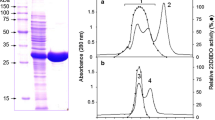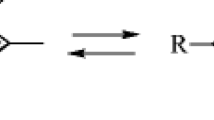Summary
3,4-dihydroxybiphenyl is not a substrate for the 2,3-dihydroxybiphenyl 1,2-dioxygenase (BphC) from biphenyldegradingPseudomonas sp. strain CB406. It acts as both a reversible inhibitor and a potent inactivator of the enzyme. The inactivation process requires the presence of O2 and can be reversed by the removal of the 3,4-dihydroxybiphenyl followed by incubation of the enzyme in the presence of dithioerythritol and Fe2+ under anaerobic conditions. Two other extradiol dioxygenases behave similarly, the catechol 2,3-dioxygenase (BphE) from strain CB406 and the BphC fromPseudomonas sp. strain LB400. The BphC fromP. testosteroni B-356 also did not cleave 3,4-dihydroxybiphenyl but it was not inactivated.
Similar content being viewed by others
Abbreviations
- C23o:
-
Catechol 2,3-dioxygenase
- 34DHBP:
-
3,4-dihydroxybiphenyl
References
Adams RH, Huang CM, Higson FK, Brenner V & Focht DD (1992) Construction of a 3-chlorobiphenyl-utilizing recombinant from an intergeneric mating. Appl. Environ. Microbiol. 58: 647–654
Ahmed D, Sylvestre M & Sondossi M (1991) Subcloning ofbph genes fromPseudomonas testosteroni B-356 inPseudomonas putida andEscherichia coli: evidence for dehalogenation during initial attack on chlorobiphenyls. Appl. Environ. Microbiol. 57: 2880–2887
Assinder SJ & Williams PA (1990) The TOL plasmids: Determinants of the catabolism of toluene and the xylenes. Adv. Microb. Physiol. 31: 1–69
Bagdasarian M, Lurz R, Ruckert B, Franklin FCH, Bagdasarian MM & Timmis KN (1981) Specific purpose plasmid cloning vectors. II. Broad host range, high copy number RSF1010 derived vector, and a host vector system for a gene cloningPseudomonas. Gene 16: 237–247
Bartels I, Knackmuss H-J & Reineke W (1984) Suicide inactivation of catechol-2,3-dioxygenase fromPseudomonas putida mt-2 by 3-halocatechols. App. Environ. Microbiol. 47: 500–505
Bedard DL & Haberl ML (1990) Influence of chlorine substitution pattern on the degradation of polychlorinated biphenyls by eight bacterial strains. Microb. Ecol. 20: 86–102
Bullock WD, Fernandez JM & Short JM (1987) XL1-Blue: A high efficiency plasmid transformingrecA Escherichia coli strain with β-galactosidase selection. Biotechniques 5: 376–379
Carrington B, Lowe A, Shaw LE & Williams PA (1994) The lower pathway operon for benzoate catabolism in biphenyl-utilisingPseudomonas sp. strain IC and the nucleotide sequence of thebphE gene for catechol 2,3-dioxygenase. Microbiology, in press
Eltis LD, Hoffman B, Hecht H-J, Lunsdorf H & Timmis KN (1992) Purification and crystallization of 2,3-dihydroxybiphenyl 1,2-dioxygenase. J. Biol. Chem. 268: 2727–2732
Furukawa K & Arimura N (1987) Purification and properties of 2,3-dihydroxybiphenyl dioxygenase from polychlorinated biphenyldegradingPseudomonas pseudoalcaligenes andPseudomonas aeruginosa carrying the clonedbphC gene. J. Bacteriol. 169: 924–927
Furukawa K & Miyazaki T (1986) Cloning of a gene cluster encoding biphenyl and chlorobiphenyl degradation inPseudomonas pseudoalcaligenes. J. Bacteriol. 166: 392–398
Gibson DT, Cruden DL, Haddock JD, Zylstra GJ & Brand JM (1993) Oxidation of polychlorinated biphenyls byPseudomonas sp. strain LB400 andPseudomonas pseudoalcaligenes KF707. J. Bacteriol. 175: 4561–4564
Haddock JD, Nadim LM & Gibson DT (1993) Oxidation of biphenyl by a multicomponent enzyme system fromPseudomonas sp. strain LB400. J. Bacteriol. 175: 395–400
Harayama S & Rekik M (1989) Bacterial aromatic ring-cleavage enzymes are classified into two different gene families. J. Biol. Chem. 264: 15328–15333
Klecka GM & Gibson DT (1981) Inhibition of catechol-2,3-dioxygenase fromPseudomonas putida by 3-chlorocatechol. App. Environ. Microbiol. 41: 1159–1165
Kuhm AE, Stolz A & Knackmuss H-J (1991) Metabolism of naphthalene by the biphenyl-degrading bacteriumPseudomonas paucimobilis Q1. Biodegradation 2: 115–120
Kuhm AE, Stolz A, Ngai KL & Knackmuss H-J (1991b) Purification and characterisation of a 1,2-dihydroxynaphthalene dioxygenase from a bacterium that degrades naphthalene sulfonic acids. J. Bacteriol. 173: 3795–3802
Lloyd-Jones G, Ogden RC & Williams PA (1994) Recombination of thebph (biphenyl) catabolic genes from plasmid pWW100 and their deletion during growth on benzoate. Appl. Env. Microbiol. 60: 691–696
Lowry OH, Rosebrough NJ, Farr AL & Randel RJ (1951) Protein measurement with the Folin phenol reagent. J. Biol. Chem. 193: 265–275
Mondello FJ (1989) Cloning and expression inEscherichia coli ofPseudomonas strain LB400 genes encoding polychlorinated biphenyl degradation. J. Bacteriol. 171: 1725–1732
Nozaki M (1970) Metapyrocatechase (Pseudomonas). Meth. Enzymol. 17A: 522–525
Nozaki M, Ono K, Nakazawa T, Kotani S & Hayaishi O (1968) Metapyrocatechase II. The role of iron and sulfhydryl groups. J. Biol. Chem. 243: 2682–2690
Polissi A & Harayama S (1993) In vivo reactivation of catechol 2,3-dioxygenase by a chloroplast-type ferredoxin: a bacterial strategy to expand the substrate specificity of aromatic degradative pathways. EMBO J. 12: 3339–3347
Ramos JL, Wasserfallen A, Rose K & Timmis KN (1987) Redesigning metabolic routes: Manipulation of TOL plasmid pathway for catabolism of alkylbenzoates. Science 235: 593–596
Sondossi M, Sylvestre M & Ahmed D (1992) Effects of chlorobenzoate transformation on thePseudomonas testosteroni biphenyl and chlorobiphenyl degradation pathway. Appl. Environ. Microbiol. 58: 485–495
Taira K, Hayase N, Arimura N, Yamashita S, Miyazaki T & Furukawa K (1988) Cloning and nucleotide sequence of the 2,3-dihydroxybiphenyl dioxygenase gene from the PCB-degrading strain ofPseudomonas paucimobilis Q1. Biochem. 27: 3990–3996
Author information
Authors and Affiliations
Rights and permissions
About this article
Cite this article
Lloyd-Jones, G., Ogden, R.C. & Williams, P.A. Inactivation of 2,3-dihydroxybiphenyl 1,2-dioxygenase fromPseudomonas sp. strain CB406 by 3,4-dihydroxybiphenyl (4-phenylcatechol). Biodegradation 6, 11–17 (1995). https://doi.org/10.1007/BF00702294
Received:
Accepted:
Issue Date:
DOI: https://doi.org/10.1007/BF00702294




